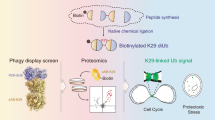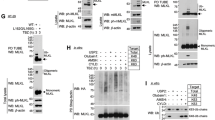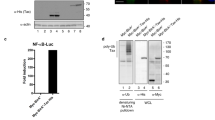Abstract
Processing of the NF-κB2 precursor p100 to the mature p52 subunit is regulated via a unique pathway. NF-κB-inducing kinase (NIK) induces IκB kinase α (IKKα)-mediated phosphorylation of specific serine residues in the C-terminal domain of p100, leading to recruitment of the SCFβ-TrCP ubiquitin ligase. We identified a single lysine residue, K855, that serves as the ubiquitin-anchoring residue required for signal-induced processing of p100. In a reconstituted system containing purified components, p100-K855R could not be ubiquitinated. In a crude extract and cells, only residual, signal-independent ubiquitination and processing were retained. Importantly, K855 is located in a site homologous to K22 that serves as an ubiquitination site in IκBα. This suggests a common recognition mechanism for the two molecules. In contrast, p105, the p100 homologue, lacks a similar Lys residue. We also demonstrate that the NEDD8 pathway is essential for the SCFβ-TrCP activity. In a reconstituted system, efficient ubiquitination of p100 required all three components of the pathway – E1, the UBC12 E2 and NEDD8. Experiments in reconstituted systems and in cells demonstrated that SCFβ-TrCP, which contains a mutant Cul-1 that cannot be NEDDylated, cannot stimulate ubiquitination and processing. Similarly, dominant negative UBC12 inhibits, in a reversible manner, both ubiquitination and processing of p100.
This is a preview of subscription content, access via your institution
Access options
Subscribe to this journal
Receive 50 print issues and online access
$259.00 per year
only $5.18 per issue
Buy this article
- Purchase on Springer Link
- Instant access to full article PDF
Prices may be subject to local taxes which are calculated during checkout








Similar content being viewed by others
References
Amir RE, Iwai K and Ciechanover A . (2002). J. Biol. Chem., 277, 23253–23259.
Baldi L, Brown K, Franzuso G and Siebenlist U . (1996). J. Biol. Chem., 271, 376–379.
Baldwin Jr AS . (2001). J. Clin. Invest., 107, 3–6.
Ben-Neriah Y . (2001). Nat. Immunol., 3, 20–26.
Fan CM and Maniatis T . (1991). Nature, 354, 395–398.
Fong A and Sun SC . (2002). J. Biol. Chem., 277, 22111–22114.
Gong L, Kamitani T, Millas S and Yeh ETH . (2000). J. Biol. Chem., 275, 14212–14216.
Gong L and Yeh ETH . (1999). J. Biol. Chem., 274, 12036–12042.
Heissmeyer V, Krappmann D, Wulczyn FG and Scheidereit C . (1999). EMBO J., 18, 4766–4778.
Hochstrasser M . (2000). Nat. Cell Biol., 2, E153–E157.
Kamitani T, Kito K, Fukuda-Kamitani T and Yeh ETH . (2001). J. Biol. Chem., 276, 46655–46660.
Karin M and Ben-Neriah Y . (2000). Annu. Rev. Immunol., 18, 621–663.
Kawakami T, Chiba T, Suzuki T, Iwai K, Yamanaka K, Minato N, Suzuki H, Shimbara N, Hidaka Y, Osaka F, Omata M and Tanaka K . (2001). EMBO J., 20, 4003–4012.
Lin A and Karin M . (2003). Sem. Cancer Biol., 13, 107–114.
Lyapina S, Cope G, Shevchenko A, Serino G, Tsuge T, Zhou C, Wolf DA, Wei N, Shevchenko A and Deshaies RJ . (2001). Science, 292, 1382–1385.
Morimoto M, Nishida T, Honda R and Yasuda H . (2000). Biochem. Biophys. Res. Commun., 270, 1093–1096.
Neri A, Chang CC, Lombardi L, Salina M, Corradini P, Maiolo AT, Chaganti RS and Dalla-Favera R . (1991). Cell, 67, 1075–1087.
Neri A, Fracchiolla NS, Migliazza A, Trecca D and Lombardi L . (1996). Leuk. Lymphoma, 23, 43–48.
Orian A, Gonen H, Bercovich B, Fajerman I, Eytan E, Israël A, Mercurio F, Iwai K, Schwartz AL and Ciechanover A . (2000). EMBO J., 19, 2580–2591.
Orian A, Whiteside S, Israël A, Stancovski I, Schwartz AL and Ciechanover A . (1995). J. Biol. Chem., 270, 21707–21714.
Osaka F, Kawasaki H, Aida N, Saeki M, Chiba T, Kawashima S, Tanaka K and Kato S . (1998). Genes Dev., 12, 2263–2268.
Palombella V, Rando O, Goldberg AL and Maniatis T . (1994). Cell, 78, 773–785.
Read MA, Brownell JE, Gladysheva TB, Hottelet M, Parent LA, Coggins MB, Pierce JW, Podust VN, Luo RS, Chau V and Palombella VJ . (2000). Mol. Cell. Biol., 20, 2326–2333.
Scherer DC, Brockman JA, Chen Z, Maniatis T and Ballard DW . (1995). Proc. Natl. Acad. Sci. USA, 92, 11259–11263.
Schwechheimer C, Serino G, Callis J, Crosby WL, Lyapina S, Deshaies RJ, Gray WM, Estelle M and Deng XW . (2001). Science, 292, 1379–1382.
Senftleben U, Cao Y, Xiao G, Greten FR, Krähn G, Bonizzi G, Chen Y, Hu Y, Fong A, Sun SC and Karin M . (2001). Science, 293, 1495–1499.
Shinkura R, Kitada K, Matsuda F, Tashiro K, Ikuta K, Suzuki M, Kogishi K, Serikawa T and Honjo T . (1999). Nat. Genet., 22, 74–77.
Wu K, Chen A, Tan P and Pan ZQ . (2002). J. Biol. Chem., 277, 516–527.
Xiao G, Harhaji EW and Sun SC . (2001). Mol. Cell, 19, 401–409.
Acknowledgements
This research was supported by grants from CapCure Israel – Centers of Excellence Program, the Israel Science Foundation – Centers of Excellence Program, and the German–Israeli Project Cooperation (DIP), AC is an Israel Cancer Research Fund (ICRF) Professor. Infrastructural equipment was purchased with support of the Wolfson Charitable Fund Center of Excellence for studies on Turnover of Cellular Proteins and its Implications to Human Diseases (to AC). REA was supported by Fellowships from the Center of Absorption in Science, Ministry of Immigrant Absorption of Israel, and the Ali-Kaufman Foundation.
Author information
Authors and Affiliations
Corresponding author
Rights and permissions
About this article
Cite this article
Amir, R., Haecker, H., Karin, M. et al. Mechanism of processing of the NF-κB2 p100 precursor: identification of the specific polyubiquitin chain-anchoring lysine residue and analysis of the role of NEDD8-modification on the SCFβ-TrCP ubiquitin ligase. Oncogene 23, 2540–2547 (2004). https://doi.org/10.1038/sj.onc.1207366
Received:
Revised:
Accepted:
Published:
Issue Date:
DOI: https://doi.org/10.1038/sj.onc.1207366
Keywords
This article is cited by
-
Ubiquitination in the regulation of inflammatory cell death and cancer
Cell Death & Differentiation (2021)
-
Manifold role of ubiquitin in Helicobacter pylori infection and gastric cancer
Cellular and Molecular Life Sciences (2021)
-
The NEDD8-activating enzyme inhibitor MLN4924 sensitizes a TNFR1+ subgroup of multiple myeloma cells for TNF-induced cell death
Cell Death & Disease (2019)
-
Non-conventional functions for NF-κB members: the dark side of NF-κB
Oncogene (2015)



